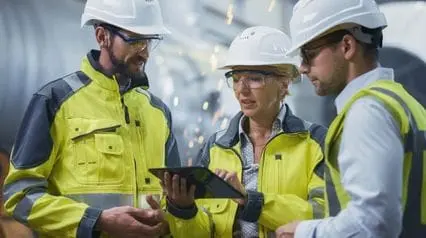What are Toolbox Talk Topics in Construction?
Construction toolbox talk topics are a regular safety meeting that takes place on the job site. They’re a great way to make sure everyone is up to speed on the latest safety guidelines. After all, when it comes to construction, safety is always of the utmost importance.
Since safety is a top priority in the construction industry, construction workers need to be constantly aware of their surroundings and the potential hazards they face on the job.
The beauty of toolbox talks topics in construction is that they’re customizable. Toolbox talks provide a forum for discussing these hazards and coming up with strategies for mitigating them.
The facilitator (usually the project supervisor) can choose the topics that are most relevant to the workers on the job site. This way, everyone is on the same page, and there’s no confusion or surprises regarding safety rules.
What is its Purpose?
A construction toolbox talk is all about keeping workers safe on the job site. By discussing potential hazards and sharing best practices, everyone can stay alert and aware of the risks they might face while working.
Toolbox talks are a great way to get everyone on the same page, and they can be tailored to match the specific needs of your project. They’re also a good way to remind workers about the safety protocols they should be following.
Top 10 Construction Toolbox Talk Topics
So what are some of the top ten construction toolbox talk topics? Here’s a list of examples to get you started:
- Fall prevention – Most construction workers deal with heights hence why falls become one of the most causes of injuries on a construction site. Fall prevention is an essential topic as it helps workers to be aware of what to do to avoid falling while on the job.
- Caught in-between – Caught in-between includes being caught, crushed, or compressed between two or more objects causing mutilation or injury to the body. It is a vital topic to discuss and be aware of the risks, as it can present dangers to workers, especially in high-risk industries. These.
- Hazard communication – Hazard communication is key to keeping workers safe as it helps them identify and avoid hazards.
- Electrical safety: Electrical safety is vital on a construction site as there are many potential hazards. These include open live wires, faulty sockets, and electrocution in wet areas.
- Personal Protective Equipment (PPE) – PPE is essential for workers on a construction site or in any workplace. Having proper work clothes such as helmets, gloves, and eye gear provides the staff protection from sudden accidents.
- Ladder safety – Ladder safety is important as often, workers don’t have information about the proper use of ladders. Falls from ladders are a common cause of injury on construction sites.
- Forklift safety – Forklifts are commonly used on construction sites, so it’s important that workers are aware of the hazards and how to use them properly and stay safe around them.
- First aid – First aid is a must for any toolbox topic as it allows your workers to provide immediate care and action in case of accidents at their site.
- Scaffolding safety – Scaffolding is commonly used on construction sites, so workers need to be aware of the hazards and how to stay safe while working on scalding. They must be well reminded not to climb and use proper access.
- Hand and power tools – Proper knowledge of handling hand and power tools will allow workers to use them correctly and prevent them from being injured.
Who Should Give the Toolbox Talk?
Toolbox talks are an essential part of any safety program and a great way to get your crew on the same page when it comes to safety. But who should give the toolbox talk?
Ideally, it should be someone with authority—someone who the crew respects and will listen to. It can be the foreman, the site supervisor, or another member of management. But it doesn’t have to be someone in a supervisory role. It could also be a tradesperson who’s been with the company for a long time and knows the ropes.
The most important thing is that whoever gives the talk is knowledgeable about the topic and is able to communicate effectively with the crew.
What Should Be Covered in a Toolbox Talk?
Safety is always the number one priority in any workplace, and toolbox talks are a great way to remind workers of the safety measures they need to take to keep themselves safe. But toolbox talks aren’t just about safety—they’re also a great way to keep workers up-to-date on the latest changes in the industry, new policies, and any other important information.
Toolbox talks should be brief and concise and cover a range of topics so that all workers are up to speed. The topics you cover will depend on your specific industry, but some of the most common ones include:
- Falls
- Electrocution
- Hazard identification
- Struck by objects
- Caught-in- between
You can also use a construction toolbox talks checklist as a guide to provide you with some of the most common fatal four in construction safety.



